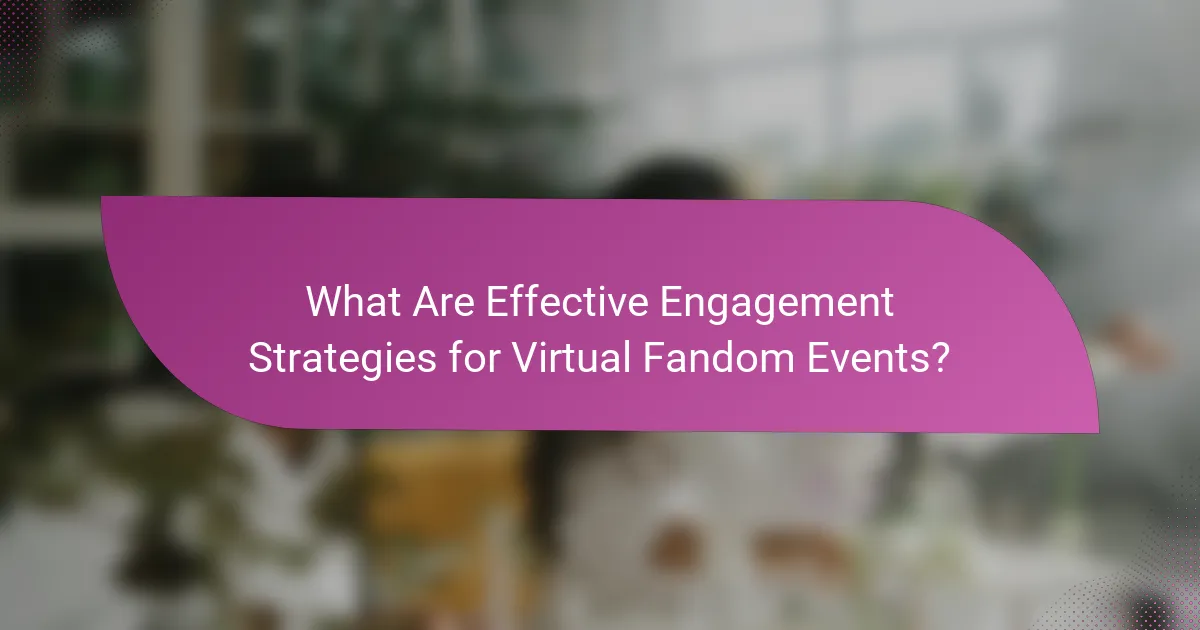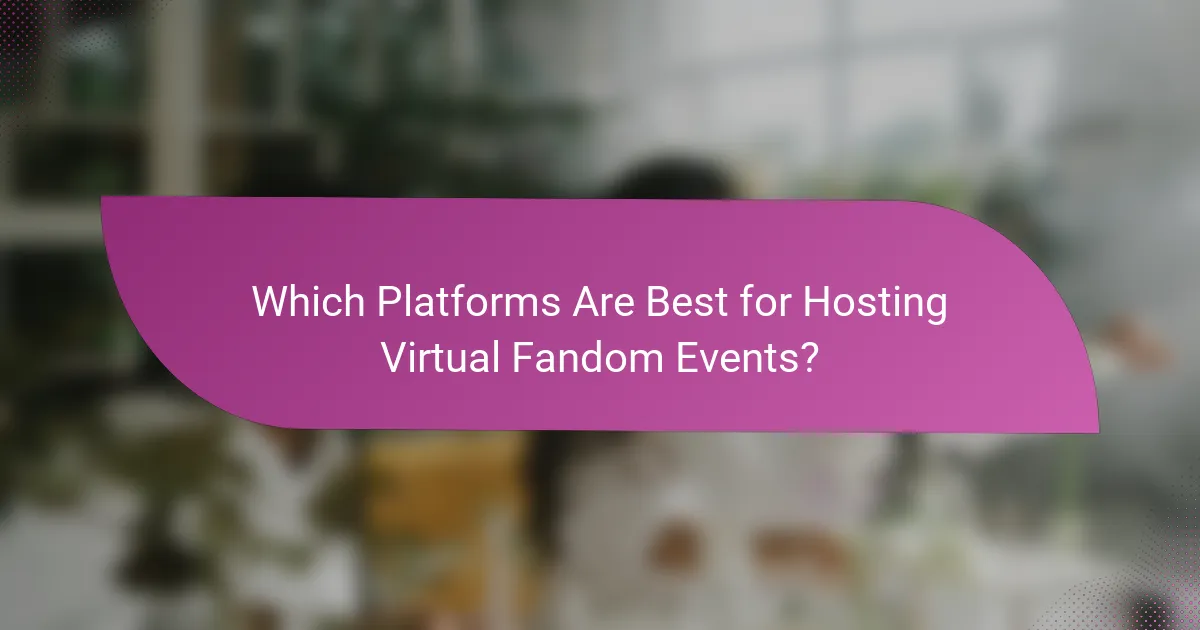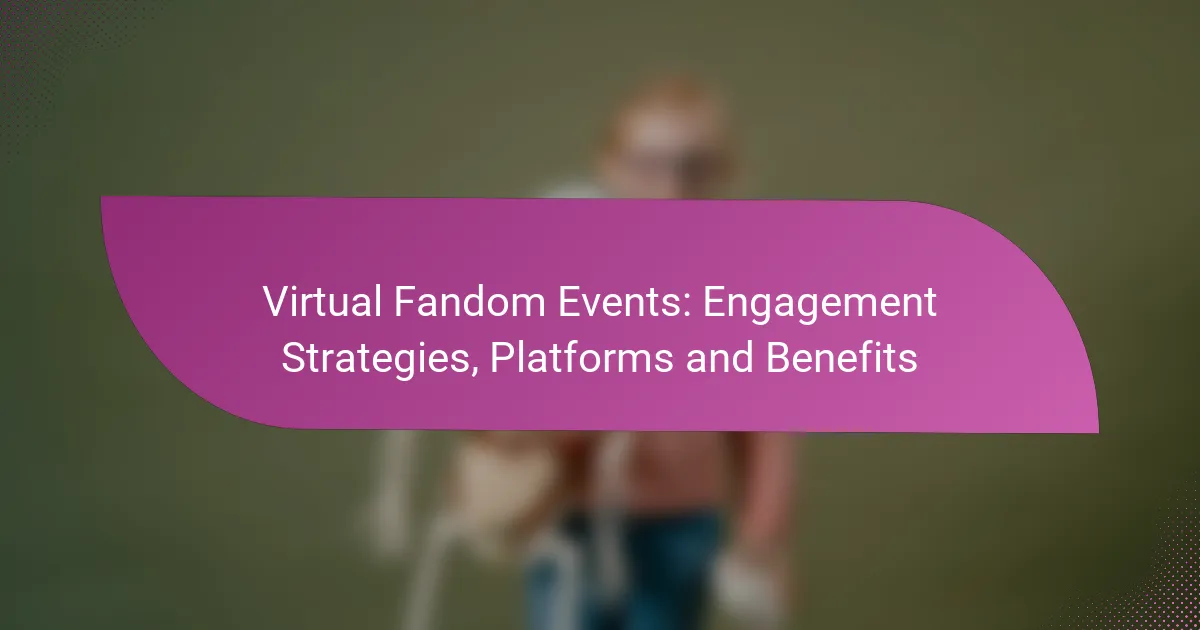Virtual fandom events have transformed the way fans connect and engage with their favorite franchises, utilizing innovative strategies to create interactive experiences. By selecting the right platforms, such as Discord or Twitch, organizers can enhance participation and foster a sense of community. These events not only provide accessibility and cost savings but also allow fans from around the world to come together, breaking down the barriers of traditional gatherings.

What Are Effective Engagement Strategies for Virtual Fandom Events?
Effective engagement strategies for virtual fandom events focus on creating interactive and memorable experiences that resonate with fans. These strategies leverage technology and creativity to foster community and enhance participation, ensuring that fans feel connected and valued.
Interactive Q&A Sessions
Interactive Q&A sessions allow fans to engage directly with creators, influencers, or celebrities. These sessions can be conducted through live chat platforms or video conferencing tools, enabling real-time interaction and feedback.
To maximize engagement, consider using a moderator to filter questions and keep the conversation flowing. Encourage fans to submit questions in advance and reward participation with exclusive content or merchandise.
Live Streaming with Influencers
Live streaming with influencers can significantly boost engagement by tapping into their established fan bases. Influencers can host watch parties, live discussions, or behind-the-scenes content, creating a sense of exclusivity and excitement.
Choose influencers whose audiences align with your fandom to ensure authentic engagement. Promote these events across social media platforms to maximize reach and participation.
Virtual Meet-and-Greets
Virtual meet-and-greets offer fans the chance to interact one-on-one with their favorite personalities. These events can be structured as small group sessions or individual video calls, providing a personal touch.
Consider using a ticketing system to manage attendance and create a sense of exclusivity. Offering different tiers of access can also enhance the experience, such as VIP packages that include additional perks.
Gamification Elements
Incorporating gamification elements into virtual fandom events can enhance engagement by making participation fun and rewarding. This can include quizzes, polls, or interactive challenges that encourage fans to actively participate.
Use leaderboards to track participation and reward top fans with prizes or recognition. Ensure that the gamification elements are easy to understand and accessible to all participants to avoid frustration.
Fan Contests and Challenges
Fan contests and challenges can stimulate creativity and community involvement. Encourage fans to submit artwork, videos, or stories related to the fandom, with winners receiving prizes or recognition during the event.
Promote these contests well in advance and provide clear guidelines to ensure a smooth submission process. Highlighting fan contributions during the event can further strengthen community bonds and encourage ongoing participation.

Which Platforms Are Best for Hosting Virtual Fandom Events?
Choosing the right platform for virtual fandom events is crucial for maximizing engagement and interaction. Popular options include Discord, Zoom, Twitch, and Facebook Events, each offering unique features tailored to different types of activities and audiences.
Discord for Community Engagement
Discord is ideal for fostering community engagement through its server-based structure, allowing fans to interact in real-time via text, voice, and video. Users can create dedicated channels for discussions, announcements, and events, making it easy to organize activities and maintain ongoing conversations.
To effectively use Discord, consider setting up roles for members to enhance organization and encourage participation. Regularly scheduled events, such as game nights or Q&A sessions, can keep the community active and engaged.
Zoom for Interactive Panels
Zoom is well-suited for hosting interactive panels and discussions, providing features like breakout rooms and screen sharing. This platform allows for a more personal connection, enabling participants to engage directly with speakers and each other.
When using Zoom, ensure to promote the event in advance and send reminders to participants. Keep sessions concise, ideally around 60 minutes, to maintain interest and encourage attendance. Consider recording sessions for those who cannot join live.
Twitch for Live Streaming
Twitch excels in live streaming, particularly for gaming and entertainment content. It allows creators to broadcast in real-time while interacting with viewers through chat, making it a dynamic platform for fandom events.
To maximize engagement on Twitch, stream regularly and interact with your audience by responding to chat comments. Utilize Twitch’s features like polls and channel points to create a more interactive experience. Collaborating with popular streamers can also help attract a larger audience.
Facebook Events for Promotion
Facebook Events is a powerful tool for promoting virtual fandom events, allowing users to create event pages, invite friends, and share updates. This platform can help reach a wider audience by leveraging existing social networks.
When creating an event on Facebook, include clear details such as date, time, and a compelling description. Use engaging visuals and encourage attendees to share the event to boost visibility. Regular updates and reminders can help maintain interest leading up to the event.

What Are the Benefits of Virtual Fandom Events?
Virtual fandom events offer numerous advantages, including enhanced accessibility, cost savings, and the ability to reach a global audience. These benefits make it easier for fans to engage with their favorite franchises and communities without the barriers of traditional in-person events.
Increased Accessibility for Fans
Virtual fandom events significantly increase accessibility by allowing fans from various locations to participate without travel constraints. This means that individuals with mobility issues, financial limitations, or those living in remote areas can engage in events they might otherwise miss.
Platforms hosting these events often provide features like live streaming and recorded sessions, ensuring that fans can access content at their convenience. This flexibility caters to different time zones and personal schedules, enhancing overall participation.
Cost-Effective Event Management
Managing virtual fandom events typically incurs lower costs compared to physical gatherings. Expenses related to venue rental, catering, and travel are minimized or eliminated, allowing organizers to allocate funds toward better technology and marketing efforts.
Additionally, ticket prices for virtual events can be more affordable, attracting a larger audience. Organizers can also offer tiered pricing models, such as basic access versus premium experiences, to cater to different budgets.
Global Reach and Audience Expansion
Virtual events enable organizers to tap into a global fanbase, breaking geographical barriers that limit attendance. This global reach can lead to increased brand awareness and community growth as fans from diverse backgrounds connect over shared interests.
To maximize audience expansion, event organizers should utilize social media and online marketing strategies to promote their events. Engaging with international fan communities and leveraging influencers can further enhance visibility and participation across various regions.

How to Choose the Right Platform for Your Event?
Choosing the right platform for your virtual fandom event is crucial for maximizing engagement and ensuring a smooth experience. Consider factors such as your audience’s preferences, technical capabilities, and the specific features offered by each platform.
Consider Audience Demographics
Understanding your audience demographics is essential when selecting a platform. Different age groups and interests may gravitate toward specific platforms, such as Twitch for gamers or Zoom for more formal discussions. Tailoring your choice to where your audience is most active can significantly enhance participation.
Gather data on your audience’s preferences through surveys or social media insights. This information will help you identify the platforms that resonate best with your target demographic, ensuring higher engagement rates.
Evaluate Technical Requirements
Each platform has unique technical requirements that can affect the event’s success. Consider factors such as internet bandwidth, device compatibility, and user interface ease. For instance, platforms like Discord may require users to download an app, while others like YouTube are browser-based.
Before finalizing your platform, conduct a technical assessment to ensure that both your team and your audience can easily access and navigate the chosen technology. This can prevent last-minute issues that may hinder participation.
Assess Engagement Features
Engagement features play a vital role in keeping your audience involved during the event. Look for platforms that offer interactive tools such as polls, Q&A sessions, and live chat functionalities. These features can foster a sense of community and make the event more dynamic.
Compare platforms based on their engagement capabilities. For example, platforms like Hopin allow for breakout rooms and networking opportunities, while others may focus solely on streaming. Choose one that aligns with your event goals and enhances audience interaction.

What Are the Key Metrics for Measuring Success?
Key metrics for measuring success in virtual fandom events include attendance rates, participant engagement, and audience retention. These indicators help organizers assess the effectiveness of their strategies and the overall impact of the event.
Attendance and Participation Rates
Attendance and participation rates are crucial metrics that reflect how many fans engaged with the event. High attendance rates often indicate strong interest, while participation rates show how actively attendees interacted with the content, such as through Q&A sessions or polls.
To measure these rates, track the number of registered users versus actual attendees. A typical goal might be to achieve attendance rates of 50-70% of registered participants. Consider using registration incentives or early-bird discounts to boost numbers.
Common pitfalls include overestimating attendance based on registrations alone. Always analyze actual participation during the event to get a clearer picture of engagement levels. Tools like live polls and interactive sessions can enhance participation and provide real-time feedback.
